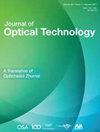基于微扫描的小型热像仪
IF 0.6
4区 物理与天体物理
Q4 OPTICS
引用次数: 0
摘要
研究主题。该课题是一种热成像相机,实现微扫描,该相机基于由碲化镉汞制成的小格式320×256光电二极管矩阵,光谱范围为8-10 μ m。研究目的。其目的是创建一种紧凑的热成像相机,光谱范围为8-10 μ m,基于小格式镉汞碲化矩阵光电探测器,使用无齿轮机电驱动来改变视场,分聚焦,校准和场景微扫描,以提高空间分辨率参数和阈值灵敏度。方法。该方法结合了光学元件机械运动的技术解决方案和基于观测场景微扫描的光电探测器灵敏度残余不均匀性校正。主要的结果。研制了一种光谱范围为8 ~ 10µm的基于小格式矩阵光电探测器(320×256像素的碲化镉汞)的微扫描热像仪。相机采用无齿轮机电驱动,允许对观察到的场景进行微扫描,改变视野,对焦和通道校准。相机配备4倍变焦镜头,最大视场21.7°×17.5°,微扫描模式下的空间分辨率为2.27mrad−1。提出的解决方案的组合使获得温差相当于噪声等于23 mK的高质量热成像器件成为可能。所提出的热像仪可用于无损检测、监视和环境监测等领域。所提出的技术解决方案将有助于在小格式矩阵中使用光电探测器评估热成像机制的高分辨率参数和阈值灵敏度。本文章由计算机程序翻译,如有差异,请以英文原文为准。
Small-sized thermal imaging camera based on micro-scanning
Subject of study. The subject is a thermal imaging camera implementing micro-scanning based on a small-format matrix of 320×256 photodiodes made of cadmium-mercury telluride featuring a spectral range of 8–10 µm.Aim of study. The aim is the creation of a compact thermal imaging camera with a spectral range of 8–10 µm based on a small-format cadmium-mercury-telluride matrix photodetector using gearless electro-mechanical drives for changing fields of view, sub-focusing, calibration, and micro-scanning of the scene to improve spatial resolution parameters and threshold sensitivity. Method. The method involves combined use of technical solutions for the mechanical movement of optical components and correction of residual inhomogeneity of the sensitivity of the photodetector based on micro-scanning of the observation scene. Main results. A thermal imaging camera with micro-scanning based on a small-format matrix photodetector (320×256 pixels of cadmium mercury telluride) with a spectral range of 8–10 µm is developed. The camera uses gearless electromechanical drives allowing micro-scanning of the observed scene, changing fields of view, focusing, and channel calibration. The camera is equipped with a 4× zoom range lens with a maximum field of view of 21.7∘×17.5∘ and a spatial resolution of 2.27mrad−1 in micro-scan mode. The combination of the proposed solutions made it possible to obtain a high-quality thermal imaging device with a temperature difference equivalent to noise equal to 23 mK. Practical significance. The proposed thermal imaging camera can be employed in the fields of non-destructive testing, surveillance, and environmental monitoring. The proposed technical solutions will be useful for evaluating high-resolution parameters and threshold sensitivity of thermal imaging mechanisms using photodetectors in a small-format matrix.
求助全文
通过发布文献求助,成功后即可免费获取论文全文。
去求助
来源期刊
CiteScore
0.90
自引率
25.00%
发文量
66
审稿时长
3-8 weeks
期刊介绍:
The journal publishes design details of a diversity of optical instruments, along with a strong section on computational optics useful to engineers, mathematicians, and physicists, as well as optical scientists. Issues of the English translation volume are published by OSA and appear at the same time as the Russian language edition, Opticheskii Zhurnal, which is produced by the Vavilov State Optical Institute

 求助内容:
求助内容: 应助结果提醒方式:
应助结果提醒方式:


